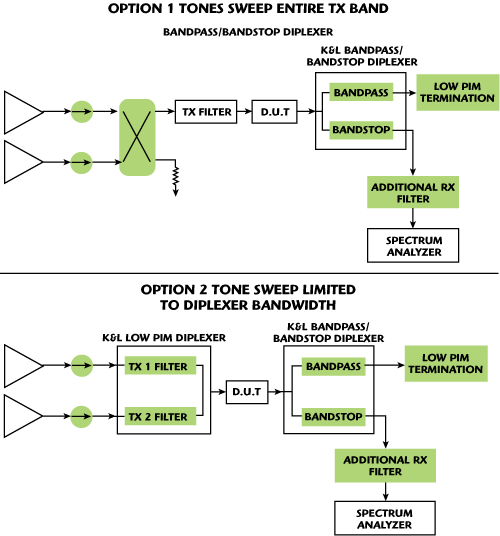
As the electromagnetic spectrum becomes increasingly crowded, regulatory agencies focus on enforcing existing regulations and establishing new ones to ensure that communications and radio location systems remain operational. In this environment, it is of paramount importance to monitor spurious emissions of systems at the design, type approval testing and production stages. K&L Microwave and sister company Dow-Key Microwave have developed a series of products to make such testing more accurate and efficient. Bandpass/bandstop (BP/BS) and lowpass/highpass (LP/HP) diplexers meeting rigid Passive Intermodulation (PIM) specifications are the essential building blocks of innovative testing system architectures. By integrating these filters with Dow-Key’s switch matrices, an OEM can construct a single automated test system capable of covering a variety of frequency bands. Test systems of this kind can be further expanded to accommodate injection of interfering signals, monitoring ports and other customer requirements.
Traditionally, diplexers are used to separate two frequency bands. K&L Microwave has designed a series of high Q cavity BP/BS diplexers to perform this function. The diplexer design features one bandpass and one bandstop filter sharing a common port. The two filters are at the same center frequency and have the same, or very similar, bandwidths in order to perform two important functions during testing. First, this arrangement provides a broadband match at the common port, maximizing performance of the device under test (DUT). Second, the two filters separate the fundamental carrier from any spurious emissions that may be created by the DUT. The DUT is connected to the common port of the diplexer, and the bandpass port can be terminated or used to test the output at the DUT’s fundamental frequency. The bandstop port is connected to a spectrum analyzer to measure the spurious emissions generated by the DUT. High Q cavity bandstop filters, by their nature, are re-entrant at approximately twice center frequency; therefore, the BP/BS diplexer cannot be used to test spurious emissions beyond that point. To measure those frequencies, an LP/HP diplexer is needed.

Figure 1 Broadband PIM monitoring.
K&L Microwave has designed LP/HP diplexers with crossovers useful for the major cellular bands. By connecting the DUT to the common port, as with the BP/BS diplexer, the far out- of-band emissions can be measured at the highpass port. These diplexers contain highpass filters that extend as far as 13 GHz to cover all of the known regulations regarding cellular spurious emissions. To simplify measurements, the LP/HP diplexer can be cascaded with a BP/BS diplexer. In this case, the lowpass port of the LP/HP diplexer is attached to the common port of the BP/BS diplexer, as shown in Figure 1.
When cascading the two diplexers together for testing, the customer will select an LP/HP diplexer with a crossover slightly below two times the center frequency of the BP/BS diplexer. Once assembled, the DUT is attached to the open common port, the bandpass port can be terminated, and spurious measurements are made at the bandstop and highpass ports, as in Figure 1. In this way, the spurious emissions of a device can be accurately determined. Of course, it is critically important that the filters used for the testing do not cause false readings. In cases where multiple high power carriers are transmitted by the DUT, one has to consider PIM that may be generated by the filters.
In order to provide the most cost-effective solution while maximizing performance, K&L Microwave offers BP/BS and LP/HP diplexers for bands of interest in three variations. Each of the variations has a guaranteed level of PIM performance allowing the customer to select filters best suited to existing needs. The base part number and lowest-cost option has guaranteed PIM of -100 dBc when subjected to two input tones of +43 dBm. For situations where somewhat better PIM performance is needed, a “-1” is added to the end of the part number, denoting PIM of -130 dBc at the input powers noted above. For the most stringent testing requirements, “-2” versions are guaranteed to meet -156 dBc PIM at the same input powers. For example, the three variations of a GSM900 BP/BS are WSD-00491, WSD-00491-1 and WSD-00491-2.

Figure 2 Reflection mode system configurations.
In addition to testing OEM transmitters as noted above, these diplexers can be used to test stand-alone passive devices for their PIM performance. In stand-alone cases, there are two basic configuration options that allow utilization of existing lab equipment to verify the PIM performance of parts. Measurement can be made using Reflection Mode or Through Mode; see Figures 2 and 3. With the system configured as shown, the PIM performance of a passive DUT can be measured at any frequency supported by the available equipment. This approach makes it unnecessary to purchase expensive equipment that can only measure PIM performance in one frequency band.

Figure 3 Through mode system configurations.
Ultimately, taking advantage of the Switch Matrix expertise of Dow-Key Microwave, these filters can be integrated into a system that allows testing of multiple functionalities over multiple frequency bands. PIM testing can be performed using broadband amplifiers, combiners, and spectrum analyzers. In applications where PIM performance is not as stringent, such as the testing of cellular chipsets, spurious out-of-band measurements can be made and coupler ports can be supplied to allow the injection of interfering signals for performance testing under simulated adverse environments. These custom test solutions can be designed to meet the exact requirements of a type approval test lab or for performance testing of production hardware. Figure 4 shows typical layouts for both PIM and small signal testing applications. Ease of calibration is an additional advantage inherent to test systems realized in this way.

Figure 4 Broadband emission test systems.
This product feature provides an overview of a scheme for assembling affordable and flexible broadband emission monitoring test systems from high-performance building blocks. Dow-Key Microwave and K&L Microwave supply cost-effective test solutions tailored to customers’ specific needs.
K&L Microwave
Salisbury, MD
(410) 749-2424
www.klmicrowave.com
